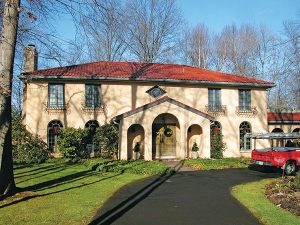Every squirrel infestation is annoying, but one that went on for three-and-a-half decades was particularly unpleasant.
In 2004, I encountered the ultimate squirrel nightmare. It seemed like something straight from the old TV series “The Twilight Zone.” Imagine the plotline pitch:
“First off, let’s pick a spot and build a house in the woods where there are plenty of squirrels. Next, let’s plan the house to be right under a large acorn tree with a large, flat-top roof that will hold thousands of acorns, attracting plenty of squirrels. Let’s make that roof from terra cotta tiles — something particularly easy for squirrels to rip apart.
“The house should be large, with at least 320 ft. of gutter. The gutters should be extra wide for the squirrels to run through quickly and easily. They should be covered with a plastic gutter guard, providing tunnels for squirrels to travel around the house undetected.
“Let’s also provide aggressive squirrels that will chew straight through the back of the gutters, right into the attic. For a finishing touch, let’s assume that all known methods of squirrel eviction have been tried and the homeowners have already suffered with the problem for 37 years.”
‘We’ve seen your kind before’
When I first drove up to the house, the squirrels were running across the stucco on the front wall, in a sort of sine wave fashion. It was almost as if to say, “This is our house. We’ve seen your kind before. Just go away.” It was freaky. I almost drove away before I knocked on the door.
Damage to the house was extensive. On each side of two separate large chimneys, squirrels had chewed an arc in the aluminum gutters to gain access to the attic. Three well-formed holes were clearly visible in the fascia above a courtyard. With a total of seven access holes, it was virtually an open house for squirrels wanting to come in and out of the attic.
None of the damage appeared to be new. This was an indication to me that the homeowners had simply given up. Trapping and baiting had been tried in the past, but they were merely harvesting the population, not solving the root cause.
Wires in the attic had been chewed, extensively. New wires had been run twice, but the homeowners proceeded to show me how, when the circuit breaker to control the outside floodlights was turned on, the breaker would kick out immediately. Squirrel urine stains were visible on the ceilings of the three bedrooms. Noise from the attic was present on a daily basis.
I arrived at that house because of my construction background and reputation for expert squirrel exclusion work. But I informed the customers (and they seemed to already know) that top-notch repairs alone would not solve their problem. The number of squirrels and their aggressiveness made it a given that after any repair was made, the squirrels would simply rip up another part of the roof or chew a new hole in the fascia somewhere else.
Upon closer inspection, I realized there were two different species living there: Northern flying squirrels (Glaucomys sabrinus) were nesting in one end and Eastern gray squirrels (Sciurus carolinensis) were living in the other end.
Before closing up all the squirrel entry and exit holes, I needed something to drive the squirrels out of the attic and destroy their desire to be there. I settled on using high-intensity strobe lights, because making an area seem like a 24/7 rave party usually leads to squirrels deciding it’s not a hospitable place to raise their young.
I worked with an electrician to install three ground fault circuit interrupter (GFCI) outlets. These allowed the high-intensity strobes to be turned on and off by a switch at the top of the attic drop staircase.
The gray squirrels soon relocated to a very large nest in the front yard. Flying squirrels like to use the hollows of trees to nest, but they are nocturnal and their activity is hard to observe. I never did find where they set up housekeeping after they left, but they were no longer trying to gain entry to the house.
The homeowners are just happy that both species left and did not come back.
Bill Earl is technical director of Pest Tools. The account described here led to his commercialization of his strobe light product, the Squirrel Evictor. He can be reached at williamlearl@gmail.com.

Leave A Comment